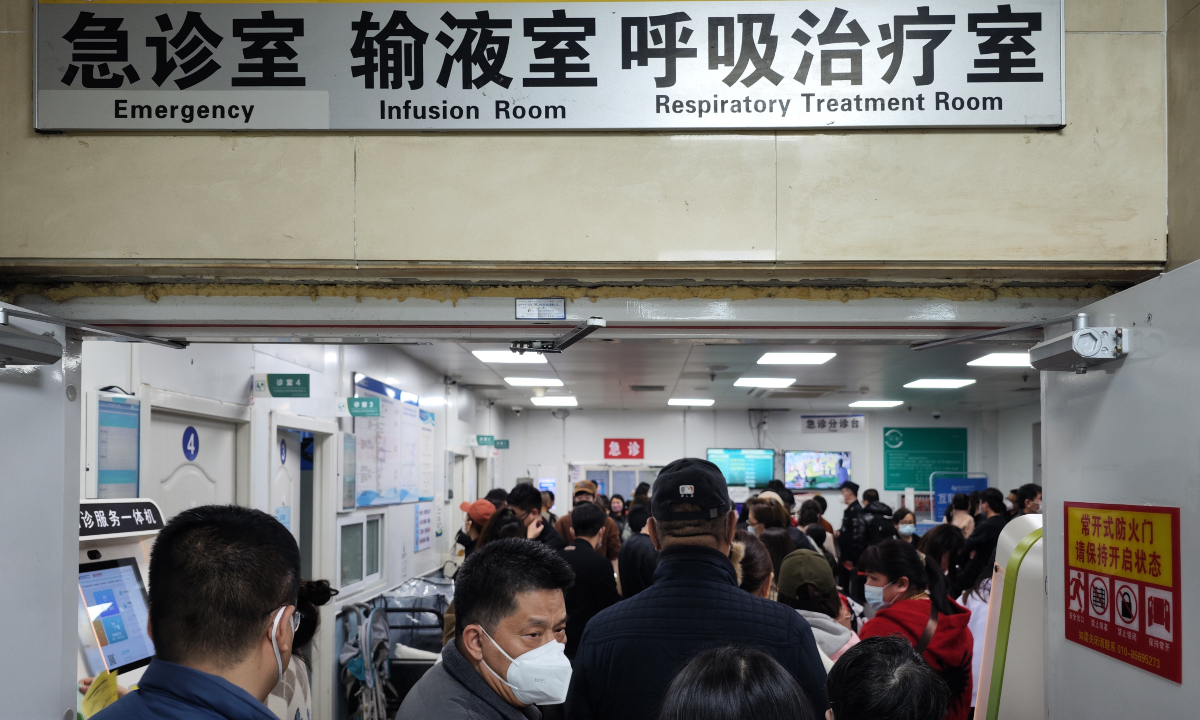
The Children's Hospital of Capital Institute of Pediatrics in Beijing crowded with patients reporting flu and norovirus like symptoms on March 6, 2023 Photo: IC
After reaching peak in mid-March, the seasonal influenza still remains at high overall levels across China with a few provinces passing an inflection point with cases declining, the Chinese National Influenza Center (CNIC) said.
Statistics from the Chinese Center for Disease Control and Prevention (China CDC) show that 53.2 percent people examined at sentinel hospitals with cold symptoms testing positive for the pathogen during the 10th week of 2023, much higher than the 0.7 percent in the fifth week.
Wang Dayan, the director of the CNIC, said on Monday that influenza activities began to increase in early February, and the rising momentum became apparent after the end of February with the transmission of the influenza virus nationwide entering its peak in mid-March, the Beijing Daily reported.
Although the level of influenza activity currently remains at a high level, China CDC has also detected an inflection point, which represents declining of the virus in a number of provinces, Wang said.
According to Wang, the flu season this year was about two months later than previous years with influenza A (H1N1) as the dominant virus followed by influenza A (H3N2).
The latest data from China CDC shows that flu positivity rates at hospitals monitored in the week ending March 12 climbed to 53.2 percent, much higher than a month earlier, which is different from the usual situation that flu spreads in winters rather than in springs.
In terms of viral prevalence, China’s flu season usually starts around the end of November, peaks in January and lasts until March, according to Wang.
However, due to the COVID-19 epidemic spiking in last December and this January, prevention and control measures against coronavirus were also effective in guarding against seasonal flu and other respiratory viruses to some degree, Wang said.
Since most people infected with COVID-19 stayed at home or staggered their working hours with most kindergartens, primary and middle schools suspending offline education, the spreading of virus through large crowds or group settings was reduced, leading to a low level of flu activity at the end of last year, Wang explained.
In terms of immunity, the influenza A (H1N1) virus has not prevailed in China over the past three years while influenza A (H3N2) and influenza B did not cause a high level of epidemic nationwide, leading to lowered awareness of influenza prevention and control among the public and low vaccination rates among the population, especially children whose preexisting immunity to influenza A (H1N1) virus was reduced, Wang said.
Since China has downgraded its COVID-19 management and optimized immigration policies on January 8, the mobility of international and domestic personnel increased and social activities became normalized, which contributed to the prevailing of influenza A (H1N1) virus during this spring, Wang said.
Seasonal flu does not only prevail in autumn, winter or spring. Some southern provinces in China also tend to experience a flu peak in the summer, which usually peaks between June and July, Wang noted.
The World Health Organization (WHO) has estimated that seasonal flu can cause 3-5 5 million severe cases of respiratory diseases and 290,000- 650,000 respiratory disease-related deaths around the globe every year. The incidence of influenza infection among children is about 20 percent to 30 percent, and in more severe epidemic seasons, annual influenza infection rate among children can reach about 50 percent, which is higher than that among adults.
Children below 5, especially the children under 2, are at high risk along with seniors aged 60 or above as well as patients with chronic diseases and pregnant women, Wang said.
Global Times

